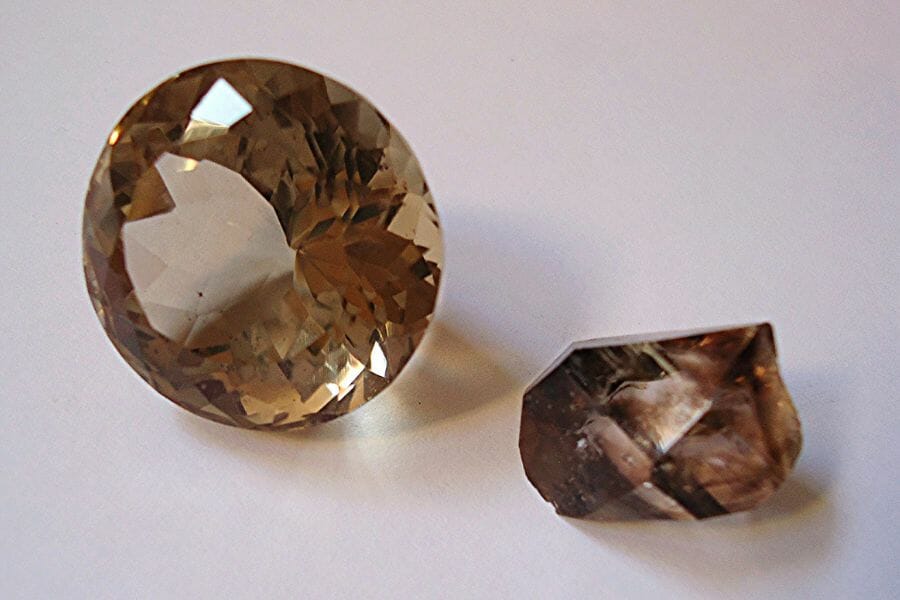Brown rocks, minerals, and gems may not be as popular as their brighter and colorful counterparts, but they’re just as mesmerizing— if not more! What’s best is that they’re abundantly found all over the world.
Brown rocks are usually carried by water, wind, or ice, and deposited in layers, giving them a unique shade and form. Most common among brown rocks are sedimentary rocks, while there are also others that are formed from solidified lava, called igneous rocks.
Brown gems, while usually less known than the others, are just as impressive. Some of the best ones include Topaz, Smoky quartz, and Zircon, which we have all discussed below.
In conclusion, brown rocks, minerals, and gems may often be overlooked, but don’t be fooled! They’re just as valuable as the colored ones and we’ll share with you here some of the most mesmerizing ones out there.
We’ll also share where you can find them and how you can identify them based on their specific properties. Let’s start!
Brown Gems and Crystals
Stare at these brown gems’ beauty through the pictures we included here and see for yourself how mesmerizing they can get.
Axinite – Ca2(Fe,Mn)Al2BSi4O15(OH)
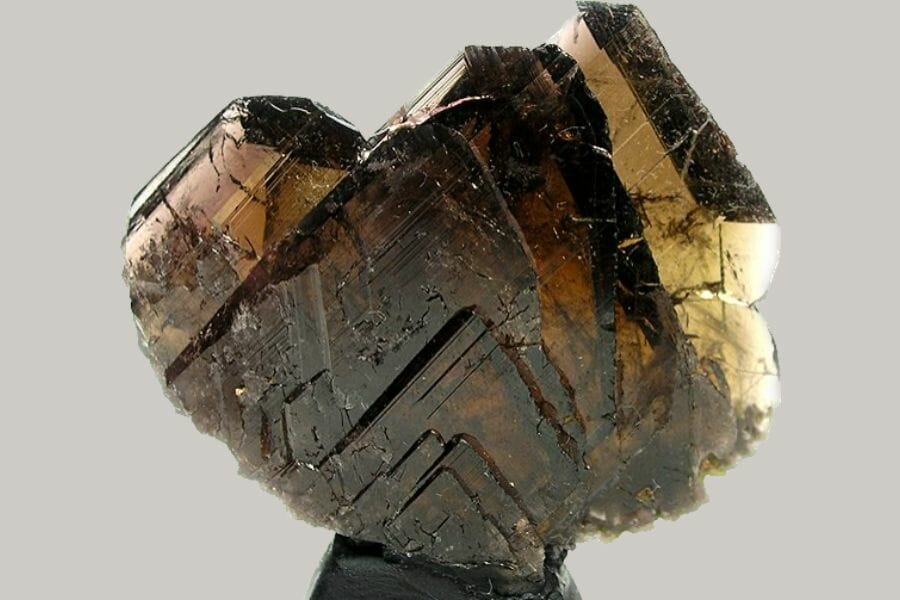
First discovered in the 19th century, Axinite is known for its beautiful brownish-red color and its unique crystal structure. It forms prismatic, rectangular-shaped crystals that are often found in clusters.
It was used in the past mainly for its ornamental value, specifically as jewelry and decor. But, in the 20th century, Axinite was discovered to have other uses, such as being a key component in the production of ceramics and glass.
Despite its widespread use today, it is still considered a valuable mineral because of its scarcity. It’s often found in small quantities in a few locations around the world. And we all know that the rarer a gem is, the more sought after it is by gem enthusiasts and rockhounds!
Fun Fact Speaking of color, did you know that Axinite is extremely pleochroic? Meaning, its color can look different when viewed from different angles. This is due to its unique crystal structure, which causes light to be absorbed differently depending on the orientation of the gem.
Where Axinite is found
Axinite may not be a very common mineral, but it can be found in a few places. Some of the countries where it has been found include the US (California, Pennsylvania, Virginia), Canada (Quebec and British Columbia), Germany, France, Italy, and Austria. It’s also been found in smaller quantities in Switzerland and Greece.
How you can identify an Axinite
- Color: Axinite is usually brownish-red and its unique color can vary depending on the location where it was formed and the minerals with which it’s associated. Its strong pleochroism also causes its color to appear different depending on the angle.
- Hardness: Axinite is considered to be of medium hardness based on the Mohs scale. It’s a durable gem, which is why it’s used for jewelry and other decorative items, and for industrial applications, such as grinding and polishing.
- Clarity: Axinite has good to fair clarity. It’s relatively transparent or translucent depending on the location where it was formed. Its clarity is also influenced by the presence of inclusions, which are tiny mineral crystals or other materials that are trapped inside the gem during its formation.
- Refractive index: Axinite has a refractive index of 1.620 to 1.724, which is considered to be of moderate to high range. This contributes to the gem’s distinctive appearance and makes it an attractive mineral for collectors and mineral enthusiasts.
- Specific gravity: Axinite’s specific gravity is 3.05 to 3.25. This is considered to be relatively high, which means Axinite is a relatively heavy gem compared to others.
Tiger’s Eye – SiO2
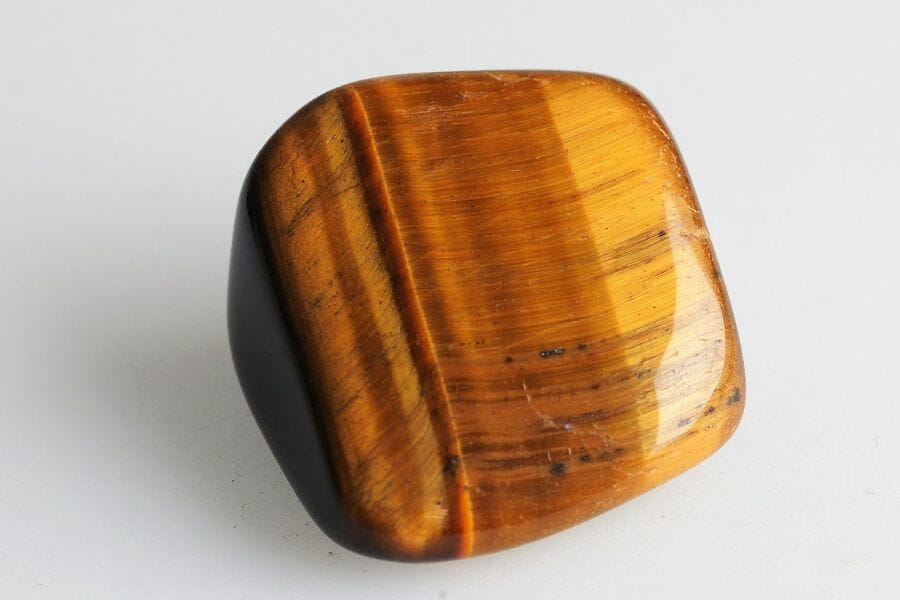
Tiger’s Eye has a rich history dating back thousands of years. This beautiful gem got its name from its distinctive appearance, which resembles the eye of a tiger with golden-brown stripes and chatoyant (or “cat’s eye”) effect.
Tiger’s Eye has been used for thousands of years for a variety of purposes: it was believed to bring good luck, wealth, and prosperity to those who wore it and it was used as a protective talisman, believed to keep the wearer safe from harm.
In modern times, Tiger’s Eye continues to be prized for its beauty and durability, as well as its unique appearance. If you’re someone who appreciates the beauty of nature, this gem is sure to capture your attention and leave a lasting impression!
Fun Fact Many people believe in the protection that Tiger's Eye can give, so much so that Roman soldier wore engraved Tiger's Eye as talisman to protect them in battle. Imagine a gemstone trumping all weapons!
Where Tiger’s Eye is found
Tiger’s Eye is found in several countries around the world, including South Africa, Australia, USA, Brazil, India and Myanmar. South Africa is known for producing high-quality Tiger’s Eye with rich golden-brown colors, while Australia is known for its light-colored specimens with softer shades of brown. Simply put, the quality and value of this gem can vary greatly depending on their origin.
How you can identify a Tiger’s Eye
- Color: It shines bright like a ray of sunshine! Tiger’s Eye has a yummy golden-brown color that looks like a mix of honey and caramel, with gorgeous stripes that make you think of a tiger’s eye.
- Hardness: Tiger’s Eye is a pretty tough gemstone with a hardness of 7 on the Mohs scale. It can handle everyday wear and tear pretty well, but you’ll still have to be gentle with it to keep it looking its best, especially if you’re wearing it as jewelry.
- Clarity: Tiger’s Eye’s clarity can vary: some are almost crystal clear, while others have a more cloudy or opaque appearance. That’s part of what makes it so unique! The more transparent and clear a Tiger’s Eye is, the more valuable it is considered to be.
- Refractive index: The refractive index of Tiger’s Eye is 1.540-1.566, which is pretty average. It gives Tiger’s Eye a nice balance between brilliance and dispersion (or “fire”).
- Specific gravity: The specific gravity of Tiger’s Eye is 2.64-2.71, which makes it feel substantial and solid in the hand. Although being on the heavier side can make it more difficult to work with, it can still be cut and polished with the right tools and techniques.
Zircon – ZrSiO₄
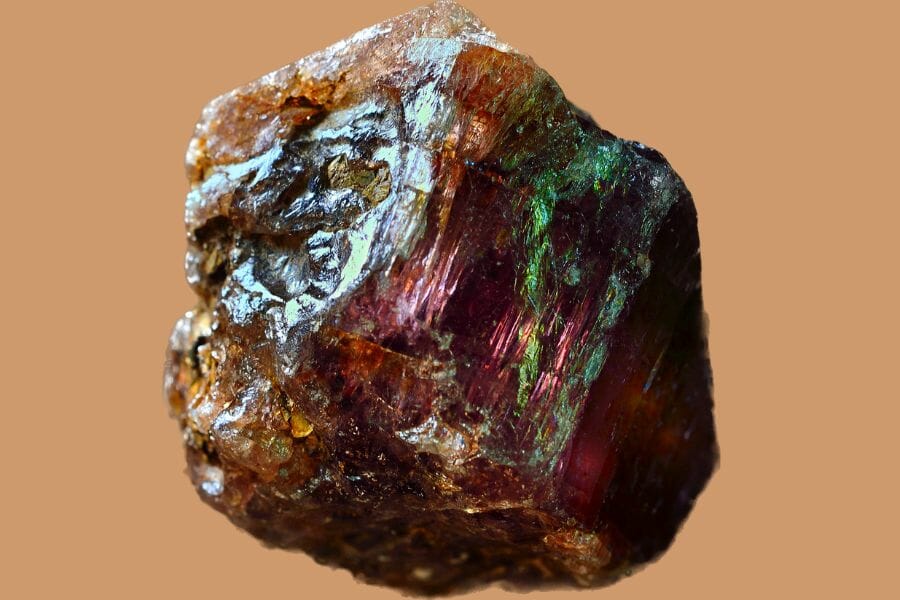
Zircon has a rich history that spans back thousands of years. It’s been valued for its beauty, fire, and brilliance!
Zircon is believed to have been first discovered in the riverbeds of India and was used as a popular gemstone in ancient times. People have been drawn to its natural beauty and have used it in jewelry, decorations, and even as a talisman to bring good luck and protection.
This gem is also known for being a good imitator of other gemstones (which is great for folks who love the look of more expensive gems but don’t want to spend a fortune). All in all, Zircon is a gemstone that’s worth getting to know!
Fun Fact Zircon is known for flashing "fire" or multipple colors of light. Just look at its photo! That's why in ancient times, people have mistaken it for diamond. It seems sparkle is not reserved to the expensive gems after all!
Where Zircon is found
Zircons can be found all around the world. They’ve been spotted in Australia, Cambodia, China, and Madagascar. In fact, some of the oldest Zircons (over 4.4 billion years old) have been found in Western Australia. But, you don’t have to travel far and wide to find these sparkly gems, because they’re also found in North America, South Africa, and even in parts of Europe.
How you can identify a Zircon
- Color: Zircon comes in a rainbow of colors! From brown, yellow, and orange to red and green. Some are even colorless, which is perfect for those who like a more subtle sparkle.
- Hardness: Zircon has a hardness of 7.5 on the Mohs scale, which is pretty impressive (considering diamonds are a 10). This means it can handle daily wear and tear without too much worry.
- Clarity: Zircon is known for its clarity: it’s “eye-clean”, which means it doesn’t have any noticeable inclusions or blemishes to the naked eye. This makes it a popular choice for jewelry that sparkles naturally.
- Refractive index: Zircon has a refractive index that’s higher than most gems, so it’s known to be bright and brilliant. It can catch light and reflect it in a million different directions, making it even more mesmerizing to look at.
- Specific gravity: Zircon’s specific gravity ranges from around 4.5 to 5.5, which is considered to be moderate-to-high. It’s a denser mineral, so it has a substantial feel in your hand. This high density contributes to its durability, making it a popular choice for jewelry and other decorative items.
Fire Agate – SiO2
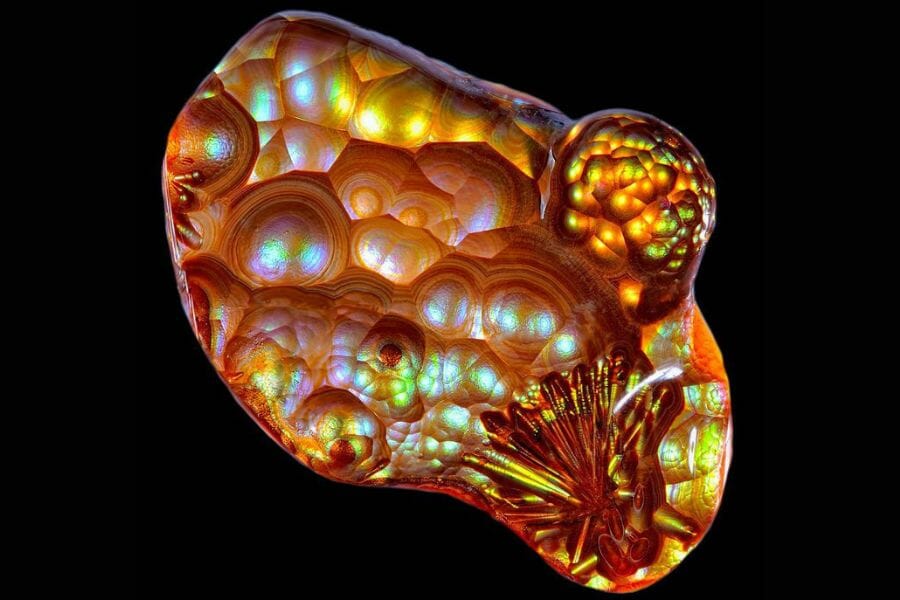
With its unique and fiery looks, Fire Agate has been mesmerizing people for centuries! It’s formed from a layer of agate with iron oxide inclusions, which create a play of color that resembles flames.
It was first discovered in the US in the 19th century and has been used for jewelry and decorative purposes ever since.
Fire Agate has been prized for it beauty and rarity, but it’s also been thought to have mystical properties. It was once believed that the fiery appearance of Fire Agate had the power to protect its wearer from harm and bring good luck.
Fun Fact:
What's the similarity between Fire Agate and your thumbmark? They're both distinct and unique (that comparison's a stretch!) No two Fire Agates are exactly alike. Each one has its own unique play of color, making it truly one-of-a-kind. So, if you're looking to add a pop of fiery fun to your jewelry collection, Fire Agates might just be the way to go!
Where Fire Agate is found
Fire Agate is typically found in the southwestern US, specifically in volcanic rocks in Arizona and New Mexico. It can also be found in smaller quantities in other countries, such as Mexico and Brazil. The best ones are said to come from the Chihuahuan Desert in the US, where they are found in areas with a lot of iron-rich volcanic rock. These gems are a treat for the eyes and a must-see for anyone interested in nature’s beauty.
How you can identify a Fire Agate
- Color: Imagine a mini volcano inside a gem— that’s what Fire Agate looks like. It has a stunning, fiery appearance that resembles an inferno burning inside a gemstone! It’s got a range of colors like brown, yellow, orange, red, green, and sometimes even blue and purple.
- Hardness: With a hardness of 6.5-7 on the Mohs scale, Fire agate is a durable and pretty tough gemstone. It can withstand everyday wear, so you can use it in jewelry without having to worry too much about scratches and damage.
- Clarity: Fire agate’s clarity can range from translucent to opaque, with some specimens having small inclusions. The best specimens are translucent with visible fire within them, giving it a unique appearance. Clarity also depends on cutting and faceting. A good cut can enhance the fire and overall appearance of the stone.
- Specific gravity: Fire agate’s specific gravity is approximately 2.6 – 2.9, which is heavy for a gemstone. Its specific gravity helps distinguish it from similar-looking stones, like chalcedony or jasper. It also contributes to Fire Agate’s durability and ease to cut and polish.
Andalusite – Al₂SiO₅
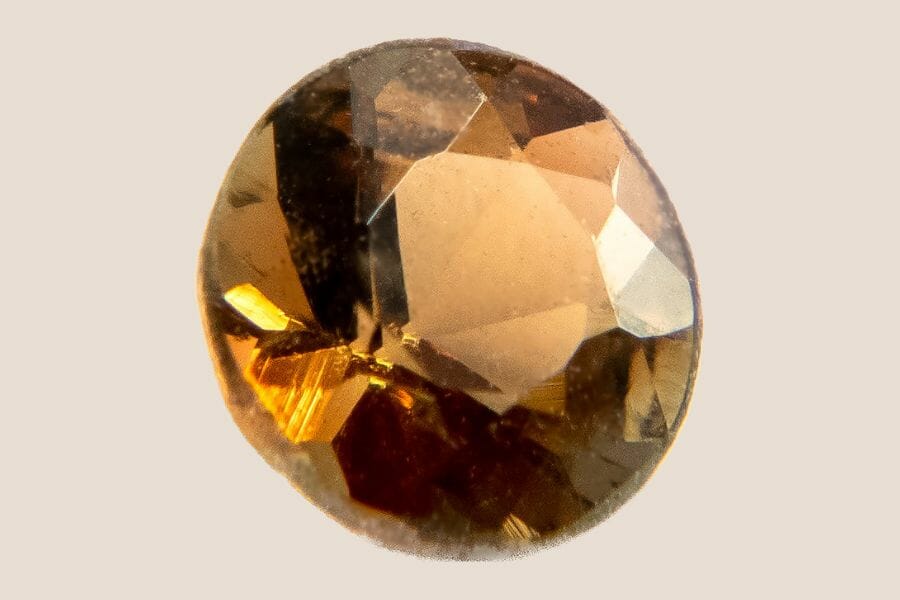
Andalusite was first discovered in the province of Andalusia, Spain, from where it got its name. It has been used for various purposes over the years— from jewelry to industrial applications— and has remained valued for its unique properties.
This gem is known for its ability to display different colors when viewed from different angles or pleochroism. It’s also heat resistant, making it useful in the production of refractory materials.
Despite being a less well-known gemstone compared to others, Andalusite has a charm and beauty that has stood the test of time, and continues to attract attention and appreciation. So if you’re looking for something a bit different, Andalusite might be just what you’re after!
Fun Fact:
Did you know that Andalusite literally glows from the inside? This gem is known as the "Schiller Stone" because of its unique property of reflecting light in a shifting manner, creating a shimmering effect that looks like an internal glow, known as "schiller". Such a mesmerizing sight to see!
Where Andalusite is found
Andalusite is found in many countries around the world, including Spain, where it was discovered, as well as in other parts of Europe, Australia, South Africa, Brazil, and the USA. The deposits of this gem can be found in metamorphic rocks, making it a valuable mineral for geological studies. With its unique crystal structure and diversity of locations, it’s sure to turn up in unexpected places!
How you can identify an Andalusite
- Color: Andalusite’s color is usually brown-red, yellow, green, or greenish-yellow, sometimes with a hint of gray. It’s pleochroic and is known for its unique color play that makes it even more beautiful.
- Hardness: Andalusite’s hardness is rated 7 on the Mohs scale, which makes it a pretty durable gem that;s suitable for everyday wear. That’s why it’s a great option if you’re looking for a gem that can withstand some wear and tear without breaking the bank.
- Clarity: Andalusite’s clarity varies from crystal clear to cloudy, but the best quality ones have good clarity with a few inclusions that don’t affect their appearance.
- Refractive index: Andalusite’s refractive index is around 1.6-1.7, which makes it a good refractor of light. This gives the gem that extra sparkle and twinkle that jewelers and jewel lovers are yearning for!
- Specific gravity: Andalusite’s specific gravity is around 3.15 – 3.20, which means it’s denser than most gems but heavier for its size.
Brown Diamond – C
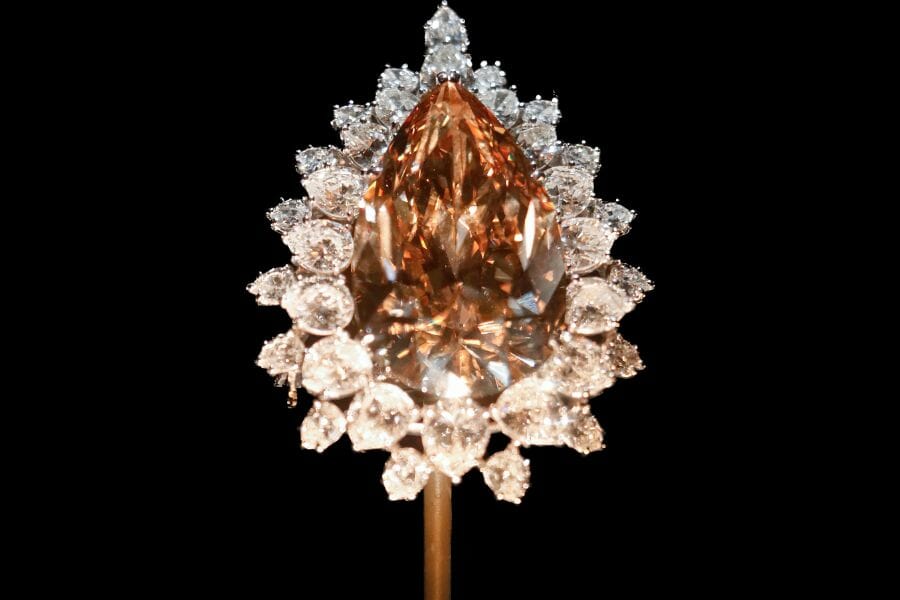
From being once considered as an “imperfect” gem because of its color, Brown Diamond has indeed redeemed its reputation. Today, its gaining popularity and is appreciated by many for its unique beauty.
Brown diamond has a long and rich history and have been a part of the diamond industry for centuries. It was first discovered in India and was often used for industrial purposes (like cutting tools) because of its durability and hardness.
This gem is quickly becoming more and more valued compared to the more traditional, colorless diamonds. It’s also a more affordable alternative, too, to other fancy-colored diamonds, making it a popular choice for engagement rings and other special jewelry.
Fun Fact: Brown Diamond comes in many names! Some people call it "champagne," "cognac," or "chocolate" diamond, depending on its exact shade of brown.
Where Brown Diamond is found
Brown Diamonds are found in various countries all around the world, including Australia, Russia, South Africa, and Zimbabwe, just to name a few. They’re often found in alluvial deposits or in mines that extract rough diamonds for other gems. These precious gems have been treasured for centuries and are widely distributed, so they’re not exactly a rarity. But, they’re still super special because of their rich history and timeless beauty!
How you can identify a Brown Diamond
- Color: Brown diamond comes in a range of shades from light to dark brown. The color comes from different factors, such as the presence of nitrogen in the gem’s crystal structure, exposure to high temperatures, or pressure during its formation. The more intense the brown color, the more valuable the diamond is considered to be.
- Hardness: Brown diamond is tough and durable! It has a Mohs hardness of 10, just like its clear counterparts, which means it’s pretty resistant to scratches and nicks.
- Clarity: Brown diamond’s clarity can vary, just like all other diamonds. Some may have inclusions, others may be eye-clean. A brown diamond’s clarity is graded on the same scale as colorless diamonds, ranging from “included” (with many visible inclusions) to “flawless” (no visible inclusions to the naked eye).
- Refractive index: Brown Diamond’s refractive index ranges from 2.4 to 2.7. This is considered to be average for a diamond.
- Specific gravity: Brown diamond’s specific gravity ranges between 2.52-2.93, depending on its chemical makeup and crystal structure. It is less dense than other diamonds, so its SG is lower, which makes it lighter than other diamond varieties.
Smoky Quartz – SiO2
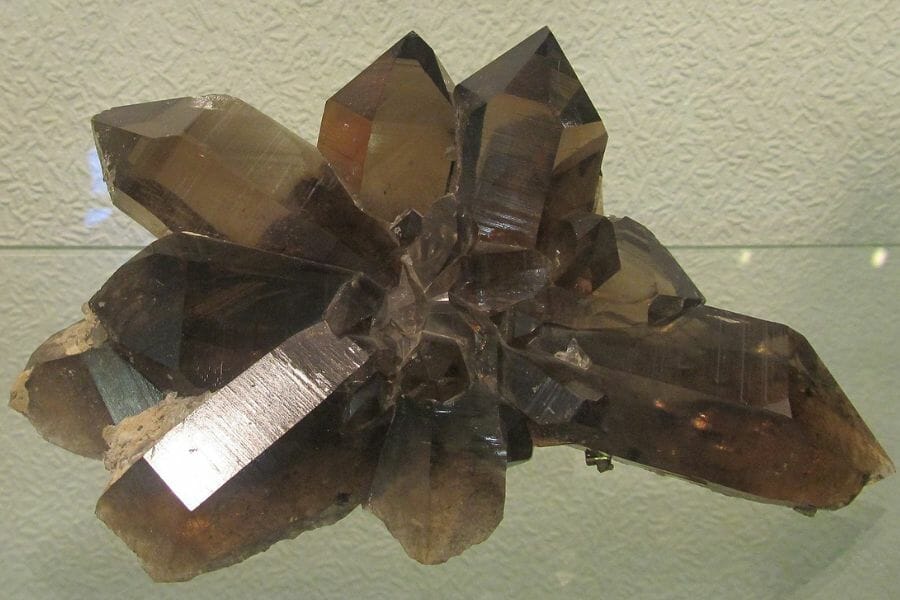
Smoky Quartz is found all over the world and has been prized for centuries for its unique color and metaphysical properties. The name “smoky” comes from the stone’s brown color, which is the result of natural irradiation.
In ancient times, Smoky Quartz was believed to be a powerful talisman that could protect the wearer from negative energy and evil spirits. It was also once used to make lens for eyeglasses and to decorate wristwatches, as well as other jewelry pieces like rings, necklaces, and earrings. It’s also a popular gemstone for making carving, sculptures and other decorative objects.
Nowadays, many people still believe that Smoky Quartz can help with depression, anxiety, and other emotional issues. It’s also said to be grounding, making it a great stone for people who are feeling overwhelmed or scattered.
Fun Fact Cairngorm Quartz, a type of Smoky Quartz found exclusively in the Cairngorm mountain range, is Scotland's national gem!
Where Smoky Quartz is found
Smoky Quartz is found all over the world, but some of the most famous locations include Switzerland, Brazil, Madagascar, Australia, and the US. Smoky Quartz is formed when natural radiation from minerals cause the color to change in the quartz. This gemstone is common in volcanic rock formations and can be found in large clusters or individual crystals.
How you can identify a Smoky Quartz
- Color: Smoky Quartz’s color is usually a translucent gray-brown to almost black hue, but can also come in pale to deep shades of brown, gray, or yellow-brown. It gets its color from natural radiation exposure and can sometimes contain inclusions (small minerals trapped inside) that enhance its natural beauty.
- Hardness: Smoky Quartz’s hardness is a 7 on the Mohs scale. It’s considered a relatively hard mineral and is resistant to scratches and damage. But it can still chip or crack if subjected to enough force or pressure.
- Clarity: Smoky Quartz’s clarity varies from crystal clear to translucent, sometimes even opaque. It usually has few inclusions or internal cracks, giving it a moderate clarity grade. Clarity depends on how it was formed and where it’s sourced from.
- Refractive index: The refractive index of Smoky Quartz is about 1.544-1.553, which is a common value for quartz varieties. It’s considered to be in the lower range of gems, which can make the stone appear darker, but can also give it a rich depth.
- Specific gravity: Smoky Quartz’s specific gravity is 2.65, which is considered average. It’s relatively heavy for it’s size and has a solid feel when held in hand. It’s a bit lighter than most other types of quartz but heavier than many other types of gems.
Brown Topaz – Al2(F,OH)2SiO4
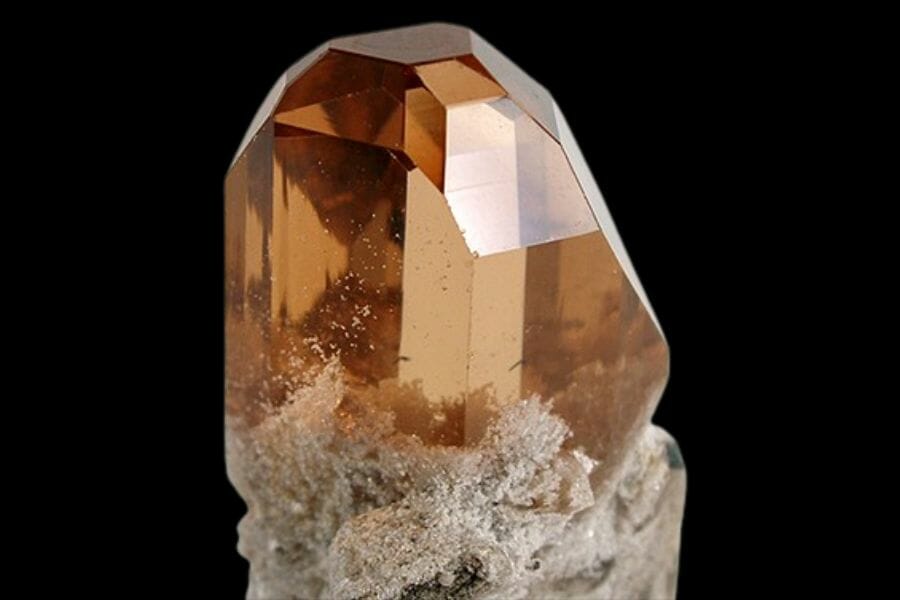
Often mistake as smoky quartz or dark-hued citrines, Brown Topaz has been around for thousands of years and has a rich history of usage and value. It’s well known for its versatile brown color that’s both rich and warm and has been used in jewelry for centuries.
Brown Topaz, which originated in Brazil, was believed to bring strength, intelligence, and good fortune by the ancient Greeks and Romans. They also used it to decorate their weapons and shields, adding to the strength. In medieval times, this gem was also believed to have the power to improve eyesight and to cure insomnia.
With its versatility, durability, and mesmerizing beauty, Brown Topaz is definitely a gem worth getting to know more!
Fun Fact The Brown Topaz that are found in Siberia are believed to be "bleached by sunlight". Talk about effective suntanning!
Where Brown Topaz is found
Brown Topaz is found in various countries such as Brazil, Nigeria, and Madagascar. It’s also sometimes found in the U.S. states of Utah, Texas, and Colorado. They’re usually found in granite and pegmatite rocks and can be mined as a byproduct of these rocks. Brown topaz is also known to be a versatile and abundant gem, and is readily available, in most cases, on the market.
How you can identify a Brown Topaz
- Color: Brown Topaz has a warm, earthy color that ranges from light tan to a rich, chocolate brown and can sometimes have red or yellow undertones. It’s usually treated to enhance its color, making it a popular choice for jewelry.
- Hardness: Brown Topaz has a hardness of 8 on Mohs scale. It’s tough enough to withstand everyday wear and tear. It can scratch less hard gems, but won’t scratch easily.
- Clarity: Brown Topaz has good clarity and is generally free of inclusions, except when the color is very dark. This gives it a bright, sparkling appearance. Its clarity affects its value, as a more transparent and clearer Brown Topaz is considered to be more valuable.
- Refractive index: Brown Topaz has a refractive index of 1.605-1.62. It’s on the lower side, but it still gives the gem a decent amount of brilliance, especially with well-cut specimens.
- Specific gravity: Brown Topaz has a specifc gravity of around 3.5-3.6, which is slightly lighter than most other gems. This is mainly due to its chemical composition.
Brown Rocks
If you’re mesmerized by the brown gemstones above, then get ready this time to be surprised by how amazing and cool brown rocks are!
Claystone – 50% Clay
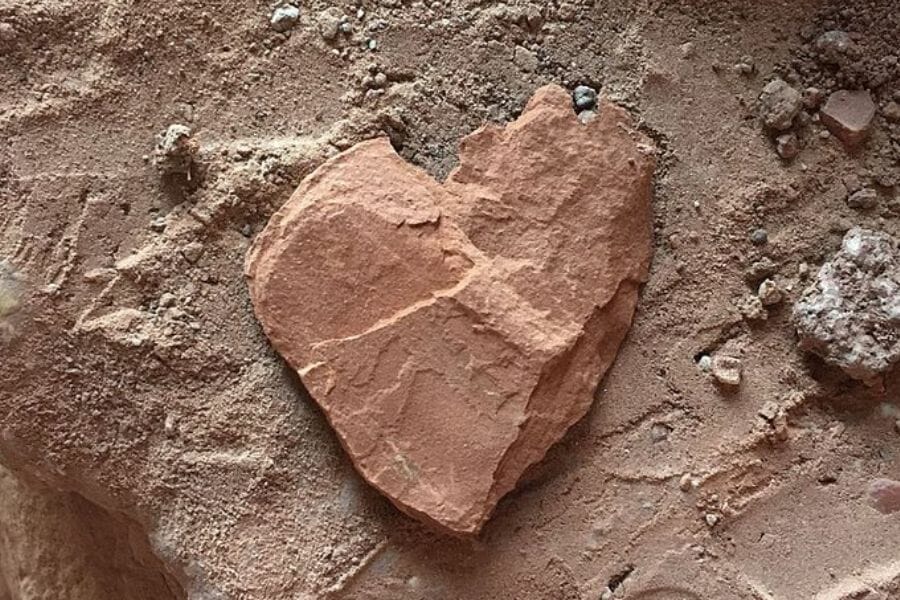
A sedimentary rock made of compacted clay particles, Claystone has been used for construction purposes, such as making bricks. In ancient times, it was also used to make pottery and other decorative items, showing its versatility as a material.
Aside from its practical uses, Claystone has also been appreciated for its beauty and natural patterns. Ranging from soft greens to warm browns and grays, its color and texture have made it a popular material for landscaping and decorating gardens. It’s often used as a decorative element in gardens and water features, adding a natural touch to outdoor spaces.
Claystone is also valued for its ability to absorb and hold water for long periods of time, making it ideal for use in irrigation systems. It can also filter pollutants from water, making it a popular material for creating natural water filtration systems. Indeed, when it comes to use, Claystone is king!
Fun Fact:
Did you know that Claystone used to satisfy the simplest leisures of the ancient civilization? That's right! Claystone has been used for thousands of years as a construction material, and the Romans actually used it to build structures like public baths, among other more important structures like buildings and aqueducts.
Where Claystone is found
Claystone is found in many parts of the world in sedimentary rock formations, such as in river deltas, lakes, and coastal plains. It can be found in different countries, including the US, Canada, Australia, Europe, and Asia. The largest deposits of Claystone are found in eastern regions of the US, particularly the Appalachian Mountains and the Illinois Basin. It can also be found in other regions with abundant sedimentary rock formations, such as the Caspian Basin in Russia and the Middle East.
How you can identify a Claystone
- Color: Claystone’s color can vary greatly depending on where it’s found and the type of clay that makes it up. However, it is most commonly found in a reddish-brown or yellow color, sometimes with hints of orange or pink tones.
- Hardness: Claystone has a hardness of 2-3 on the Mohs scale. It’s a soft rock that’s relatively easy to scratch or chip. This is due to its high content of fine-grained clay minerals that give it its unique properties, but also make it susceptible to weathering and erosion over time.
- Clarity: As a rock, Claystone doesn’t have a clarity like that of gems or minerals. But it can have variations in texture and appearance, depending on its mineral and organic content. Some Claystones have a smooth, fine-grained texture, while others are coarser, with visible layers and sedimentary structures.
- Specific gravity: Claystone’s specific gravity is variable, depending on its mineral content, but it can range from 2.0 to 2.7 g/cm³. It has a low density compared to most rocks, which makes it a light-weight option.
Gneiss
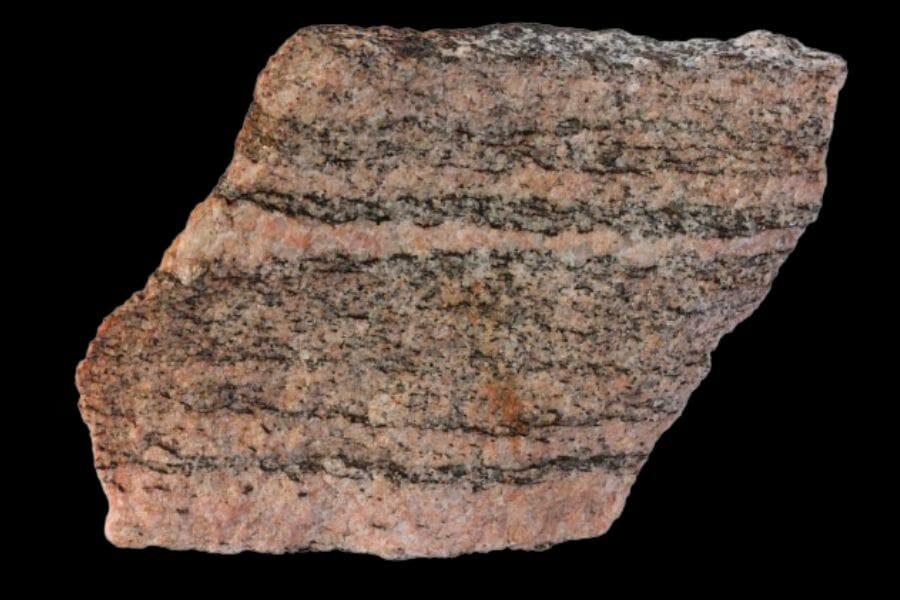
Gneiss (pronounced “nice”) is a type of metamorphic rock that’s formed when existing rock is subjected to high pressure and temperatures, causing the minerals within to re-arrange and form new bonds. This process can take millions of years, but the end result is a rock that’s tough and full of character!
Some ancient civilizations used Gneiss as building material, while others used it for weapons or tools. It was even used for ornamental purposes in some cultures. In modern times, Gneiss is still valued for its durability and natural beauty. It’s often used as a decorative stone in building and landscaping projects, or as a facing stone in buildings.
Gneiss is valued because of its unique combination of strength and beauty. Its distinctive patterns and textures, created by the formation process, make it an eye-catching and appealing material.
Fun Fact: When we say Gneiss is old, we mean 4 billion years old! This makes it one of the oldest rock types on earth, which is pretty amazing!
Where Gneiss is found
Gneiss is found in many parts of the world, including regions with ancient mountain ranges, where high pressure and temperature conditions have caused the formation of the rock. Some notable areas include the Appalachian Mountains in the eastern US, the European Alps, and parts of Russia and Scandinavia. Gneiss also occurs in some Precambrian Shield areas, such as the Canadian Shield and the Finnish Shield.
How you can identify a Gneiss
- Color: Gneiss’ color can vary greatly, but typically ranges from shades of brown, gray, black, white and/or green. It can also contain different minerals, which can give it speckled or mottled appearance.
- Hardness: Gneiss has a hardness of 4-6 on the Mohs scale. It’s a tough and durable rock that’s often used as a building and decorative stone in construction projects, and as a decorative rock in landscaping. However, it’s not recommended for high traffic areas or as countertops in kitchens due to its low hardness compared to other kinds of rocks.
- Clarity: Gneiss clarity is usually unclear as it’s a metamorphic rock.
- Refractive index: Gneiss’ refractive index is typically between 1.5-1.6, so it’s not considered to be a refractive material.It has a complex mineral composition and its refractive index varies depending on its exact composition, the presence of inclusions, and it’s texture.
- Specific gravity: Gneiss’ specific gravity typically ranges from 2.6 to 2.9 (g/cm3). This is considered to be on the heavier side for rocks, which is why it’s used in construction and other industrial purposes.
Shale
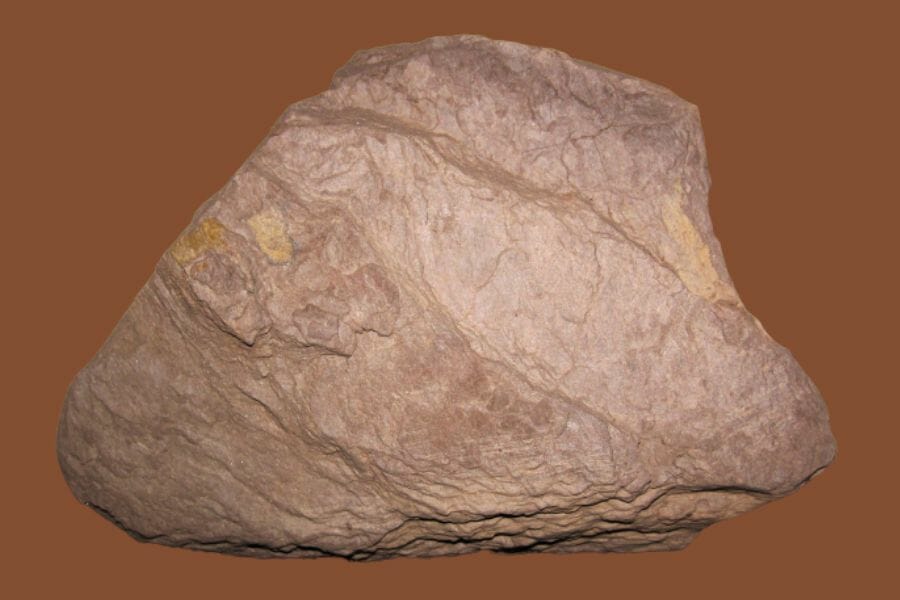
Shale is a type of sedimentary rock formed by the accumulation of mud and clay. It’s been around for a long time and has a rich history dating back to ancient civilizations that utilized it for various purposes.
Shale was used in early construction, as a building material and as a fuel source. In fact, it’s still used today as a source of natural gas and oil. It’s also known for its unique characteristic and ability to preserve fossils.
Despite its humble beginnings, Shale has come a long way, and is now valued for its versatility and durability. In fact, it’s become so popular that there’s even a Shale industry, with mines and quarries dedicated to extracting this rock type.
Fun Fact:
Did you know that Shale is often referred to as the "Memory of the Earth?" It contains a rich record of ancient environments, such as oceans, lakes, and swamps, captured in its layered rock formations. Scientists study Shale to learn about the Earth's past climate, biology, and geology. Talk about a multi-talented rock!
Where Shale is found
Shale can be found all over the world in various regions, from the Americas to Asia, Europe to Africa. Some of the largest Shale reserves can be found in the US and China, but significant deposits are also present in other countries such as Canada, Russia, and Argentina. Shale rock can form in shallow, marine environments and often contain abundant organic material.
How you can identify a Shale
- Color: Shale is typically dark in color, ranging from a deep, rich brown to almost black. It can sometimes have a greenish tint, but that’s less common. The color is due to the presence of organic matter and iron compounds in the rock.
- Hardness: Shale’s hardness varies from soft to moderately hard, as it ranges from 1-6 on Mohs scale. Its exact hardness depends on the exact composition and amount of minerals present in the rock.
- Clarity: Shale’s clarity varies based on type, but it’s often described as being opaque or having a cloudy, hazy appearance due to the microscopic clay mineral particles that it’s made of.
- Refractive index: The refractive index of Shale can vary depending on its composition and the minerals it contains, but generally it’s between 1.45-1.60, which is considered low.
- Specific gravity: Shale’s specific gravity is typically low at 1.0-2.0 due to its composition. It’s not as dense as other rocks, but its specific gravity varies depending on the amount of mineral content and organic material.
Rhyolite
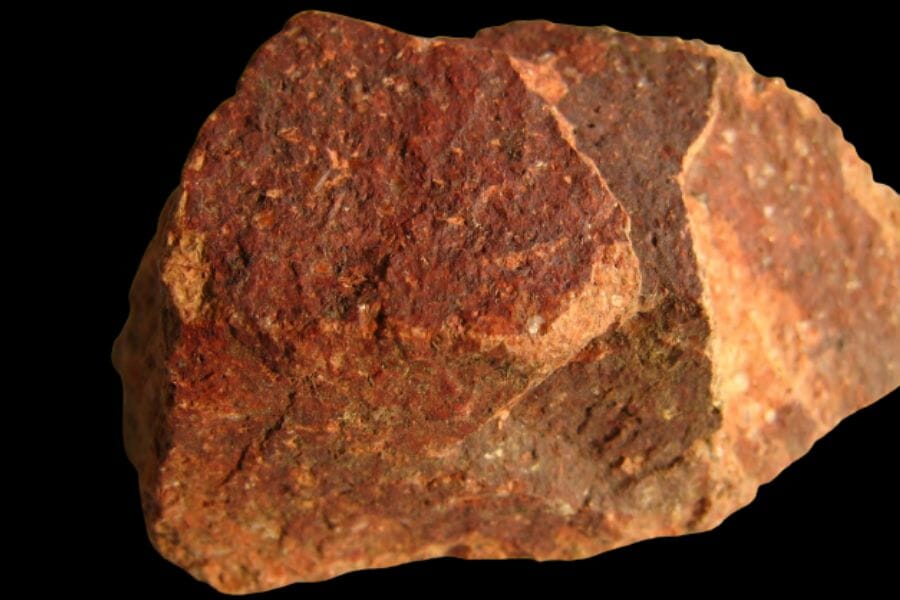
Rhyolite is a volcanic rock that’s been around for millions of years! This rock type is made of volcanic ash and lava that cools rapidly, which gives it a fine-grained texture. It has been used in a variety of ways throughout history, from ancient civilizations using it for tool-making and construction to more recent uses in jewelry and ornamental objects.
Blessed with unique combination of colors and patterns, Rhyolite is so valued today because of its beauty and versatility. It can be carved and polished into beautiful sculptures or used in jewelry. It’s also popular in landscaping because of its natural beauty and durability.
So, whether you’re looking for a pretty piece of jewelry, a unique landscaping rock, or a fascinating piece of geological history, Rhyolite is a great choice!
Fun Fact
Rhyolite has an unofficial twin! You read that right. It's often found in the same area as Obsidian, a gemstone. In fact, ancient civilizations used Rhyolite and Obsidian together, taking advantage of each of their unique properties.
Where Rhyolite is found
Rhyolite is found in various regions around the world, but mainly in areas with volcanic activity, such as mountain ranges and plateaus. Some of the most famous places for rhyolite deposits are the western US, including Nevada, California, and Arizona, as well as New Zealand, Australia, and South America.
How to identify a Rhyolite
- Color: Rhyolite’s color can vary greatly, ranging from reddish brown, light gray, pink, yellow, green, and black. It depends on the mineral content of the rock. It’s often characterized by its glassy texture and can have streaks of white and black.
- Hardness: Rhyolite’s hardness varies, but it’s considered to be a relatively soft rock, with a hardness of around 5 on the Mohs scale. It’s not very durable or scratch-resistant, that’s why it’s often used as a decorative stone or in landscaping, but not typically in construction or other applications where a hard, durable material is required.
- Clarity: Rhyolite’s clarity vary based on composition and presence of inclusions. However, many specimens have a glassy appearance, with a smooth surface that is somewhat reflective. This gives them a somewhat “clear” appearance, despite not being fully transparent.
- Refractive index: Rhyolite’s refractive index is usually low to moderate, often resulting in a dull, translucent appearance, which can sometimes look opaque when the rock is thick.
- Specific gravity: Rhyolite’s specific gravity ranges between 2.65-2.75, which is slightly less dense than the average rock. This low density is due to its high silica content.
Brown Minerals
Talk about beauty and functionality in one piece— that pretty much sums up how brown minerals are! Here are some of the best ones you will find out there.
Copper – Cu
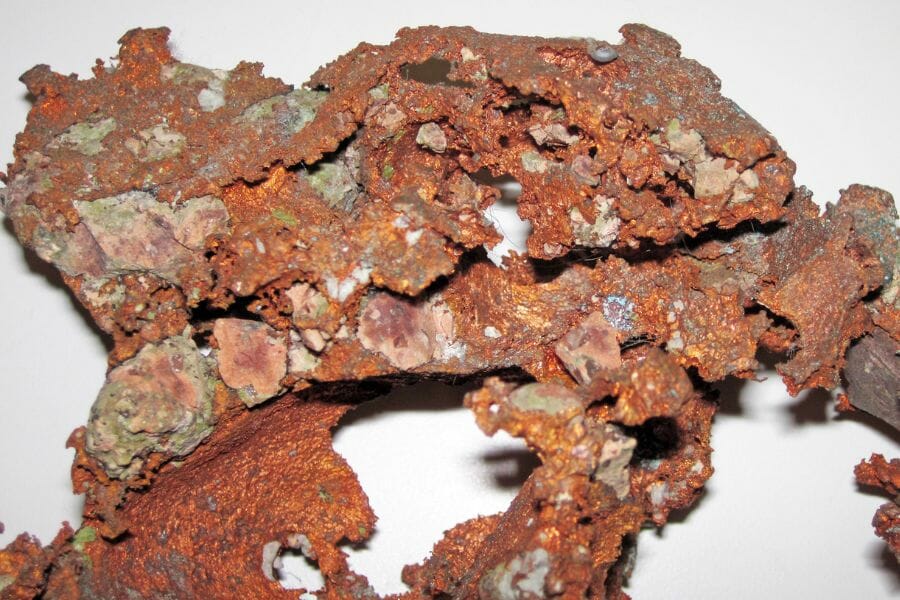
Copper has been around since the dawn of civilization! It’s one of the oldest metals known to mankind, and it’s been used in all sorts of things— from jewelry to pipes and electrical wiring. It’s even in the coins you use everyday!
Copper is a great conductor of heat and electricity, which makes it ideal for use in electrical wiring and heat exchangers. It’s also resistant to corrosion and has antimicrobial properties, making it a popular choice for use in plumbing and water systems.
But, copper’s not just useful, it’s also beautiful! It can take on a variety of hues depending on the minerals it’s combined with. Copper’s also one of the few metals that can be worked without breaking, so it’s perfect for intricate designs and sculptures.
Fun Fact:
Copper was used by the ancient Egyptians, Romans, and Greeks, and they were so impressed by its ability to be shaped and molded, to the point that they even believed it was a gift from the gods!
Where Copper is found
Copper is often found in ore deposits along with other minerals. The United States, Australia, Indonesia, and Peru are among the top copper-producing countries. In the U.S, it is extracted mainly from Arizona, Utah, New Mexico, and Montana. It’s also found in Canada, Russia, and several European countries like Poland and Sweden. Copper is so versatile, it can be found in many places, making it an important and valuable resource.
How you can identify a Copper
- Color: Copper is a shiny and brassy brownish red-orange color. It’s natural hue is unique and recognizable. Its color can change depending on the environment it’s in: When it’s exposed to air and moisture, it begins to oxidize and form a greenish layer on its surface, known as patina.
- Hardness: Copper is a relatively soft mineral, with hardness that’s between 2.5 and 3 on Mohs scale. It’s a ductile material that can be stretched and bent into shapes without breaking. Copper is also malleable, which means it can be hammered or pressed into sheets without cracking.
- Clarity: Copper doesn’t have a clarity in the traditional sense. It’s considered to be opaque and doesn’t let light pass through it easily. When polished, Copper has a high luster, reflecting light in a beautiful way that draws attention.
- Refractive index: Copper has a refractive index of about 1.93. However, it may vary depending on composition and temperature.
- Specific gravity: Copper’s specific gravity is 8.96 g/cm^3. It’s relatively heavy compared to other minerals: denser than Aluminum but lighter than Gold and Silver.
Geothite – α-FeO(OH)
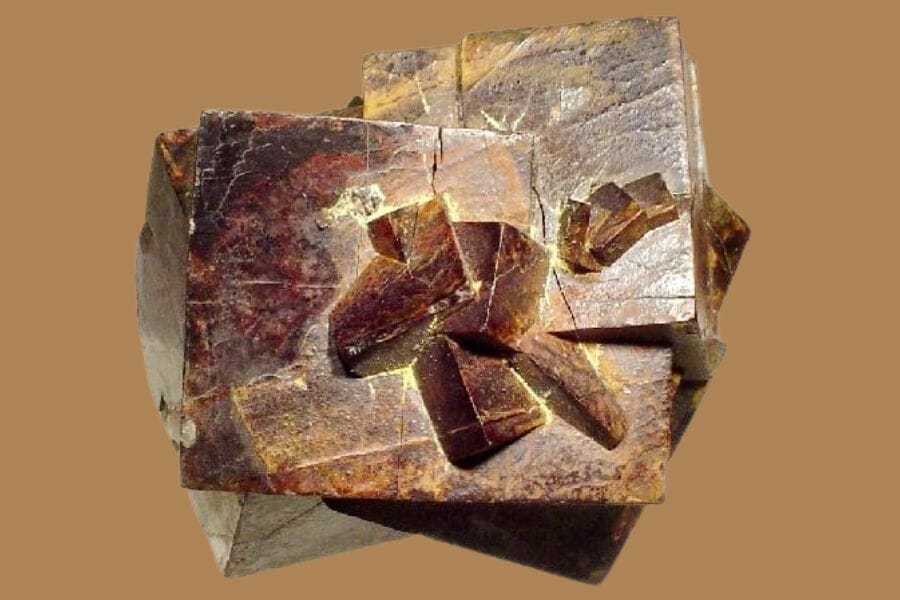
Geothite, also known as “limonite”, is a yellowish-brown to brownish-black mineral that’s made up of hydrated iron oxides. It was first discovered in the ancient times, and was used for pigments in paint and dyes. It’s also been used to make iron since it contains iron ore. It was even used as a source of iron during World War II, when other sources were scarce.
Nowadays, Geothite is still valued for its iron content, but also for its other mineral impurities such as nickel, cobalt, and gold. These impurities make it an important mineral for the production of iron, steel, and other metal alloys.
Overall, Geothite may not be a flashy mineral, but it’s definitely a valuable one, with a long history of being used in many important ways.
Fun Fact:
The name "Geothite" comes from the Greek word "Geo" meaning earth and "Ithos" meaning likeness. Simply put, Geothite is like the earth in mineral form!
Where Geothite is found
Some of the largest deposits of Geothites are found in Australia, Brazil, Russia, South Africa, and the USA. But it can also be found in smaller quantities in other countries, such as India and China. It’s often found in iron-rich soils and sedimentary rocks, and can also be found in volcanic rocks and hydrothermal veins. The distribution of Geothite is widespread, so it’s easy to find, but the quality and amount of this mineral in each deposit can vary greatly.
How you can identify a Geothite
- Color: Geothite is commonly dark brown or black in color. When it’s fresh and unweathered, it is usually a deep, rich black, but as it ages and is exposed to the elements, it can become a lighter, more brownish color.
- Hardness: Geothite’s hardness can range from 5 to 5.5 on the Mohs scale. It’s a relatively soft mineral, and can be easily scratched with a fingernail.
- Clarity: Geothite’s clarity varies. It’s not always crystal clear: sometimes it can appear opaque or dull and other times it’s shiny or iridescent.
- Specific gravity: Geothite’s specific gravity varies between 3.5 to 4.5 g/cm3, depending on its mineral composition. It’s a heavy mineral due to its high iron content, and has a higher density than many other minerals.
Monazite – (Ce,La,Nd,Th)(PO4,SiO4)
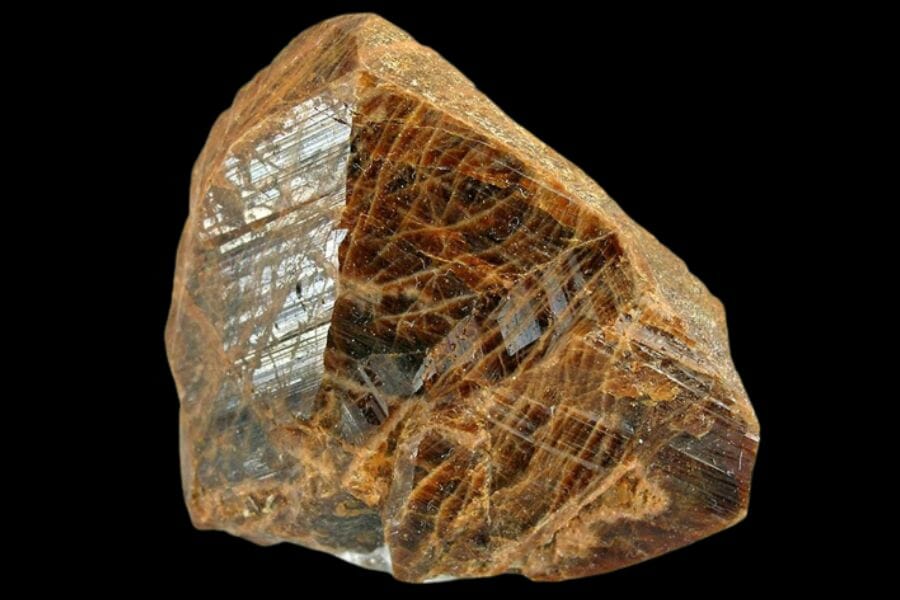
Monazite is a mineral that’s been around since the late 19th century. It’s valued for its rare earth elements (REEs) content, including cerium, neodymium, and lanthanum. These elements are used in a variety of tech products, like smartphones, laptops and wind turbines.
In the early days of its discovery, Monazite was used for ornamental purposes, but its true value was later realized when it was found to contain valuable REEs. Mining for monazite is not an easy task as it’s often found in small, scattered deposits. But once it’s extracted, the REEs are separated out and used in a variety of high-tech applications.
So if you’re into geology or tech, you’ll definitely want to keep an eye on Monazite. It’s a fascinating mineral with a rich history and a valuable future. Who knows what kind of tech advancements we’ll see in the coming years thanks to this mineral!
Fun Fact:
Not only does it make our modern day technologies possible, Monazite also helps reduce human's carbon footprint! It contains small amounts of radioactive elements such as thorium and uranium that make it useful in nuclear reactors and dating geologic events.
Where Monazite is found
Monazite is found in various locations around the world, such as in beach sand deposits, in certain types of rocks (like granite, pegmatite, and schist), and in certain mineral deposits. It’s particularly abundant in places like India, Australia, Brazil, South Africa, and parts of Europe and the US. The concentration of Monazite varies in different deposits, but its unique composition, a combination of rare earth elements and thorium, makes it an attractive target for mining in many parts of the world.
How you can identify a Monazite
- Color: Monazite is usually brown or yellow in color, but can also be found in shades of orange, red, or green. Its unique color, combined with its rarity, makes it a sought-after mineral for collectors.
- Hardness: Monazite’s hardness depends on the location of the deposit and the impurities that are present, but it’s typically around 5 on the Mohs scale. Known to be brittle if hit of bent too much, it’s relatively soft and can be scratched by a knife.
- Clarity: The clarity of Monazite can vary from transparent to translucent to opaque. Some specimens may have a cloudy appearance or inclusions, depending on the presence of impurities such as other minerals or cracks within the crystal structure.
- Refractive index: Monazite’s refractive index is around 1.7 to 1.8, which is moderate compared to other minerals. So while it’s not as clear as glass, it still has a bit of a glow to it!
- Specific gravity: Monazite’s specific gravity varies between 4.5 – 5.5, depending on the amount of heavy elements it contains. It’s a relatively dense material compared to other minerals.
Phlogopite – KMg₃AlSi₃O₁₀(F, OH)₂
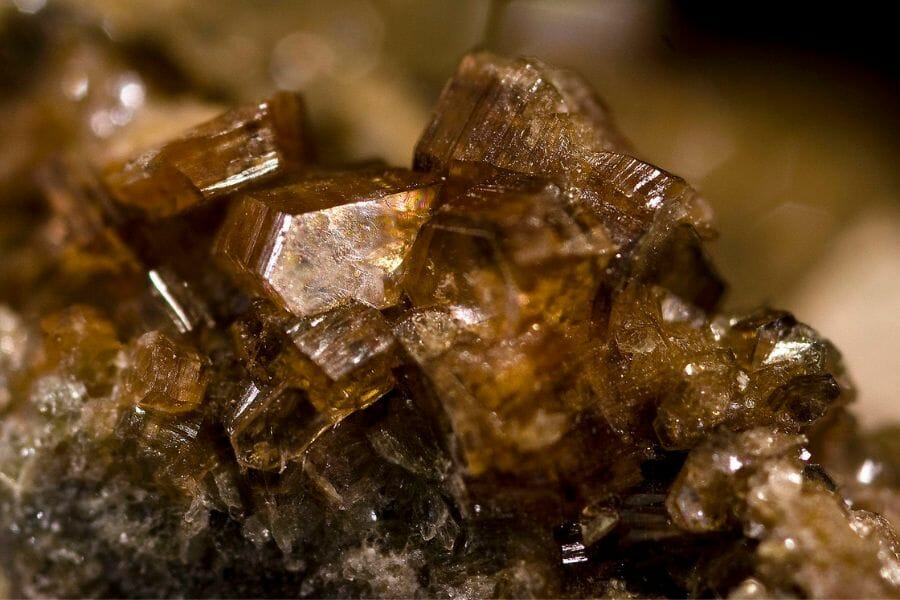
Phlogopite is commonly found in various rocks and minerals, including igneous and metamorphic rocks. This mineral, which looks like a sparkly sheet of paper, has been valued for centuries due to its unique properties and beauty.
Phlogopite was first discovered in the early 19th century, but its history of use dates back even further. In ancient civilizations, it was prized for its reflective properties and was used to make mirrors and other reflective objects. Additionally, it was believed to have medicinal properties and was used as a remedy for various ailments.
Today, Phlogopite is widely used in various industries, including the construction and electrical industries, where it is used as a fireproofing and insulating material.
Fun Fact:
Due to its unique reflective properities and ability to absorb and retain moisture, Phlogopite is widely used in cosmetics, paints, and adhesives. Talk about versatility!
Where Phlogopite is found
Phlogopite is a pretty common mineral, so it can be found in many places around the world. You can find it in Canada, Finland, India, Madagascar, and even the US. You can also find it in some parts of South America and Africa. If you’re looking for Phlogopite, you’ve got lots of options where to look!
How you can identify a Phlogopite
- Color: Phlogopite’s color is typically a yellowish-brown or greenish-brown. It can also have hints of red, pink, or orange. It has a mottled appearance, and often has flecks of darker colors that contrast with the lighter tones. It’s not usually very bright or vivid, but rather muted and subdued.
- Hardness: Phlogopite’s hardness is generally rated at 2.5-3 on the Mohs scale. For a mineral, this is considered still quite hard— it can even scratch glass and can’t be scratched by a knife!
- Clarity: Phlogopite is usually transparent or translucent, but it can also be opaque. There are also instances when it can be crystal clear. Generally, it lacks sharpness and doesn’t have a high degree of clarity, but still has enough for the observer to make out details.
- Refractive index: Phlogopite’s refractive index is typically 1.56-1.66, with higher values indicating a greater amount of light being bent.
- Specific gravity: Phlogopite’s specific gravity is typically 3.0-3.2 g/cm³ and can range from 2.9-3.4 g/cm³. Its density is lower than most other minerals.
Betafite – (Ca,U)2(Ti,Nb,Ta)2O6(OH)
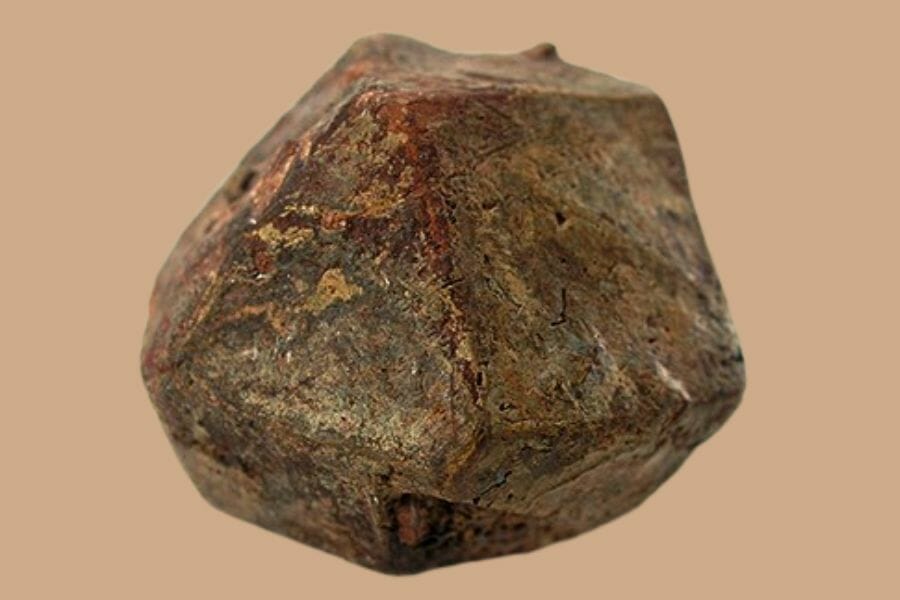
Betafite is a mineral that has been around for centuries, but was only recently discovered in the late 19th century. It’s an iron-titanium phosphate mineral and is usually brown, black, or dark green in color. It was first found in the Ural Mountains of Russia and has since been found in other places such as Brazil, Canada, Germany, Madagascar, and the US.
Betafite is valuable because of its unique chemical composition that makes it useful for many different applications. For example, it’s used to make lasers and optical fibers because of its ability to absorb light. It’s also used to make special alloys for tools and machinery because of its high strength and durability. Betafite has been used by jewelers too; it can be cut into beautiful gemstones.
In addition, Betafite has become increasingly popular among collectors due to its rarity and unique appearance. Its presence in meteorites also adds to the intrigue surrounding this mineral.
Fun Fact
Betafite is believed to be the result of the breakdown of other uranium minerals due to radioactivity. It's often found in pegmatites, granites, and metamorphic rocks. And while Betafite can be artificially produced in a laboratory setting, some believe that it may have come from outer space!
Where Betafite is found
Betafite is found mainly in Norway, Sweden, and Finland. It’s also seen in Russia, Canada, and the US in rare cases. Interestingly, Betafite can be found in certain rocks, especially syenites and nepheline, as well as in some meteorites. It’s also been found in pegmatites.
How you can identify a Betafite
- Color: Betafite’s color can range from light pink to a dark brownish-red. It’s usually flecked with white or yellowish spots. It’s also sometimes speckled with black and brown specks, giving it an almost marbled look.
- Hardness: Betafite’s hardness typically ranges from 5-7 on the Mohs Scale, which is considered to be quite hard. This puts it between glass and steel in terms of durability. Its resistance to scratches and abrasions make it an ideal material for jewelry and ornamental items.
- Clarity: Betafite’s clarity is usually good to excellent, with no major inclusions, hazing or clouding. It’s generally transparent and can sometimes show a slight greenish tint. It doesn’t often have visible fractures or flaws, and when it does they’re usually minor.
- Refractive index: Betafite’s refractive index ranges from 1.75 to 2.25, and is higher than that of most minerals. It’s also a doubly-refracting mineral, which means light passing through it splits into two rays, giving it a unique optical property.
- Specific gravity: Betafite’s specific gravity is typically around 5.6-7.0, which means it’s denser than most minerals.
Descloizite – PbZn(VO4)(OH)
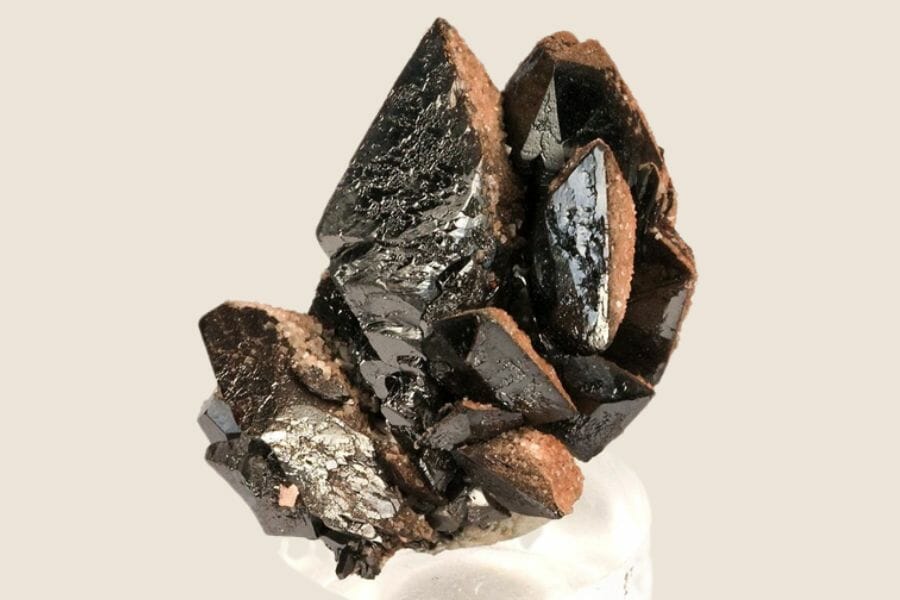
Descloizite has been valued by many cultures throughout history. It usually forms in radiating crystal clusters or crusts of small prismatic crystals. It has a unique color combination that makes it very attractive to collectors.
Since its discovery in 19th century, Descloizite has been used for various purposes such as jewelry making and ornamental carvings. It also has some interesting metaphysical properties, including protection from negative energy and promoting courage during difficult times.
Many people believe that wearing or carrying it can help them stay grounded during times of stress or turbulence in their lives. It’s also often used as an aid for meditation, spiritual growth, and emotional healing due to its calming energy vibrations.
Fun Fact The name Descloizite comes from the 19th century French mineralogist Auguste Des Cloizeaux, who discovered the mineral in 1868 in Portugal.
Where Descloizite is found
Descloizites are a rare mineral that can be found in several locations around the world, including Mexico, Russia, Namibia, and South Africa. It is most commonly found as an accessory mineral in limestones and dolomites. Descloizites can also be found in hydrothermal veins associated with lead-zinc deposits.
How you can identify a Descloizite
- Color: Descloizite’s color is reddish-brown to dark brown. It can also appear black with a hint of purple or blue. It’s often characterized by its yellowish-brown streaks, and may contain lighter shades of brown or yellow.
- Hardness: Descloizite’s hardness is 4 on the Mohs scale. It’s got a smooth, but gritty feel when touched and can scratch glass. It can’t be scratched by a knife and it won’t dent when hit with something like a hammer.
- Clarity: Descloizite’s clarity is fairly good, with some inclusions and occasionally some cloudiness. It’s not always crystal clear, but it’s usually free of eye-visible imperfections. It can range from transparent to translucent or even opaque.
- Refractive index: Descloizite’s refractive index is typically around 1.596-1.6 in air and 1.572-1.58 in oil.
- Specific gravity: Descloizite’s specific gravity is 3.3-3.5, which means it’s a relatively heavy mineral.

